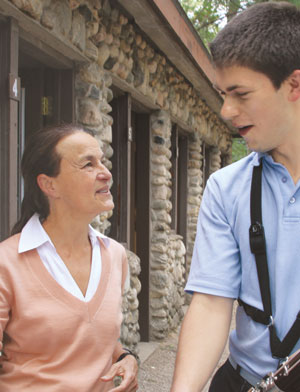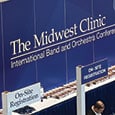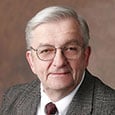(Libby Larsen with Interlochen bassoonist)
 For more than 30 years, Libby Larsen has worked full time as a composer and has created more than 400 compositions. Her music ranges from operas and symphonies to solo and chamber pieces. She was a resident composer with the Minnesota Orchestra and a cofounder of The American Composers Forum in St. Paul, Minnesota, which helps aspiring composers.
For more than 30 years, Libby Larsen has worked full time as a composer and has created more than 400 compositions. Her music ranges from operas and symphonies to solo and chamber pieces. She was a resident composer with the Minnesota Orchestra and a cofounder of The American Composers Forum in St. Paul, Minnesota, which helps aspiring composers.
Libby Larsen was born on Christmas Eve in 1950 and grew up in Minneapolis where she has remained. She attended a parochial school through eighth grade that provided a solid grounding in music as an academic discipline. Her entire first grade class “learned to write in musical, numeric, and alphabetic languages. I started writing music then – simple lines and pieces – and progressed from there. I composed vocal pieces, instrumental works, and ritual pieces, including a real-time opera that took place on the playground of our school.”
In high school she composed choral and piano works and discovered in college that theory classes opened up a new world. “Because I had been writing music since first grade, I found composition on my own. My parents supported my decision to study composition but encouraged me to find work outside of music. After six months in the insurance industry, I knew that my life was in music.”
She returned to school and became a teaching assistant in the physics department but was determined to become a composer. “I decided to spend a summer as a chambermaid at the MacDowell Colony to learn how composers set up their studios. I cleaned the studios of Aaron Copland, William Schuman, Lester Trimble, Stefan Wolpe, and William Woods and brought them their lunches too. We also had brief but lovely conversations. What a summer!” She earned bachelor’s, master’s, and doctoral degrees from the University of Minnesota where she studied with Dominic Argento and Eric Stokes.
Compositional Process
Larsen’s compositional process is highly cerebral. “This part of my process is not at all about notes or rhythms – which doesn’t occur until much later.” Rather, she works “through the unknown until I settle on the thoughts and feelings that become the foundation of the work. For example, An Introduction to the Moon uses a written score combined with portions of improvised music. My idea was one of collaboration, enabling the musicians to feel the process of creation.
“In Ursa, my recently completed work for solo tuba and wind ensemble, the yearning of a great soul proved to be the pivotal concept.” It is interesting that Larsen spent the most time on this portion of composing. “Ideally, a composer would spend this time in solitude, but in the reality of my busy life, I often work through this part while gardening or cleaning the house. My brain is freed to work while I tend to other things.
“Eventually, I move on to choosing colors, timbres, and the architecture of the work. I begin to understand the important element of energy within the composition. At this point, I still have not begun writing anything on paper, but the elements of the work are coming together in my mind.
“When I begin to put notes on the page, I first use large sheets of manuscript paper and sketch chords and motivic ideas. An onlooker would think that this barely resembles a musical composition. The page is often filled with arrows and mathematical formulas that aid me in the next step of the process.”
After this stage, she sits down at the piano and begins to write out the full score and fleshes out the details of the work. “Early in my career, when I wrote the double barline at the end of a work, I considered the compositional process to be 100% complete. After gaining greater experience, when I finish this step, I consider the work to be about 93% complete.” When the piece is rehearsed for the first time, she often adjusts parts for better balance or transitions. “I do not consider the composition to be complete until the work has been presented to an audience.”
An Introduction to the Moon
I met Libby Larsen during a summer workshop at the University of Minnesota in the mid-1990s, and she had us laughing, crying, wondering, and listening in remarkable ways. As I learned more about her compositions, I persuaded my school district in Apple Valley, Minnesota to engage Larsen as a composer-in-residence in 2002 to work with middle school, high school, and two all-state bands. Most of her previous band compositions, which were few in number, were difficult to play and available only by rental. I wanted to commission her to write a work that was playable by school groups.
When we talked about how the new piece might contribute to the wind band repertoire, she mentioned the idea of creating a work that would be a collaboration between the composer and performers; the musicians would help create and improvise the music.
The result was the composition, An Introduction to the Moon, a 12-minute, moderately difficult work that my wind ensemble premiered in May 2005. It has since been performed by numerous high school and college ensembles. The instrumentation is for standard wind ensemble plus water glasses tuned to C and G and a Marine Band C harmonica. It is available through Oxford University Press. An Introduction to the Moon combines music she created with improvised music by the ensemble. Central to the work are eight moments or spaces during which readers recite poetry. While the score provides music leading up to and following each poem, an improvised accompaniment for each poem is left to the conductor and the ensemble.
The work is based on the poem “Moon” by former U.S. Poet Laureate Billy Collins. The score includes Larsen’s poetry suggestions for the next seven sections of the work by such poets as Langston Hughes, Emily Dickinson, Ralph Waldo Emerson, and Kahil Gibran among others. Conductors are welcome to use other poems related to the moon, although the first poem by Billy Collins poem should always be used.
The temptation with An Introduction to the Moon is to create a continuous flow of improvised sound beneath the poetry. While this appears to be an enriching idea, it is more engaging to highlight only particular words or phrases of the poetry, embellishing the text to make it more meaningful. It also helps to remember that while the ensemble becomes familiar with the text during several rehearsals, listeners hear the poetry only once and without aid of printed text. That aspect of creating the improvisations is parallel to the central goal of musical composition – communicating clearly to listeners an idea or thought or feeling on a first hearing.
Every time I conduct the work, I record the poetry before rehearsals begin. This eliminates the technical and logistical problems inherent with live oration, such as difficulties with the volume of the speaker’s voice, the speed at which the person speaks, clear enunciation, etc.
First Moments of The Music
In comparison to her earliest work for wind band, Grand Rondo from 1988, the tonal and motivic ideas of An Introduction to the Moon are unmistakably true to Libby Larsen’s compositional style. The nine sections of composer-created material are scored so that they tie together the complete work when the poetry improvisations are included. When paced well, the music moves along in a fashion that is satisfying to listeners.
Interpretive Decisions
The tempos of the various sections of the work vary between quarter = 52 and 88 beats per minute, allowing for some variety while remaining true to the mystical quality established early in the work. Subtle changes of tempo are important in realizing each of the sections of the work and need attention and thought. That being said, it is essential to the integrity of the work that the music proceed seamlessly into and out of each poem.
Short of a few passages, the rhythmic difficulties of the work are modest. Much greater is the challenge of performing the rhythmic material well at slow tempos in an exceptionally effortless way. Exact articulations from all the wind musicians are a must, as are unimpeded releases, often al niente.
Typical of Larsen’s style is percussion writing that is meaningful, colorful, and a delight. The contributions from this element of the ensemble are tasteful, subtle, and in a few cases require advanced technical skill (in particular on vibraphones and marimba). Mature percussionists will be pleased with the ways their contributions propel the work forward.
The work has brief solos for alto saxophone, tenor saxophone, trumpet, and piccolo. Involving other players as soloists during the poetry adds to the possibilities for creating contrasting textures in the improvised sections.
Additional Thoughts
A few unusual aspects of the work are worthy of mention. The flute, oboe, and clarinet sections require water glasses tuned to concert G. The trombone, euphonium, and tuba sections require water glasses tuned to concert C. The Marine Band Harmonica in the key of C, included in the instrumentation, is affordable and available from most music stores. Mutes for tuba and euphonium are also needed.
The ending of the piece will also provide the conductor and ensemble with a collaboration to create an ensemble – al niente – closure to the work. The final four measures of music are performed eight times, with instruments gradually and seamlessly leaving the texture until only the harmonica and water glasses remain.
Judicious planning and leadership from the podium are critical to the smooth transitions into and out of poetry presentations and improvisations. You will need to provide cues and guidance from the podium based on notations in the score, but because there is little room in the score to write such notes, I suggest you create a supplemental document for them. A second music stand can hold your improvisation scripts with cues.
The published edition of the work has a number of errors, both in the score and parts. A thorough errata list is available to download from Libby Larsen’s website (www.LibbyLarsen .com). The site also includes a streaming recording of the entire composition and a nonprintable PDF of the conductor’s score.
Life as a Full-Time Composer
Libby Larsen has never held a teaching position at a college or university; she works as a composer, full time. “I have been lucky enough to have the kind of musical life I wanted,” she says, “and so I never felt the need to be attached to an academic institution.”
In spite of the lack of a formal teaching position, her interactions with students of all ages are warm, gracious, and always engaging. Following a residency with Larsen, one high school student simply remarked, “The way I listen to the world around me will never be the same.” Once you listen to her music, you very well may agree.





